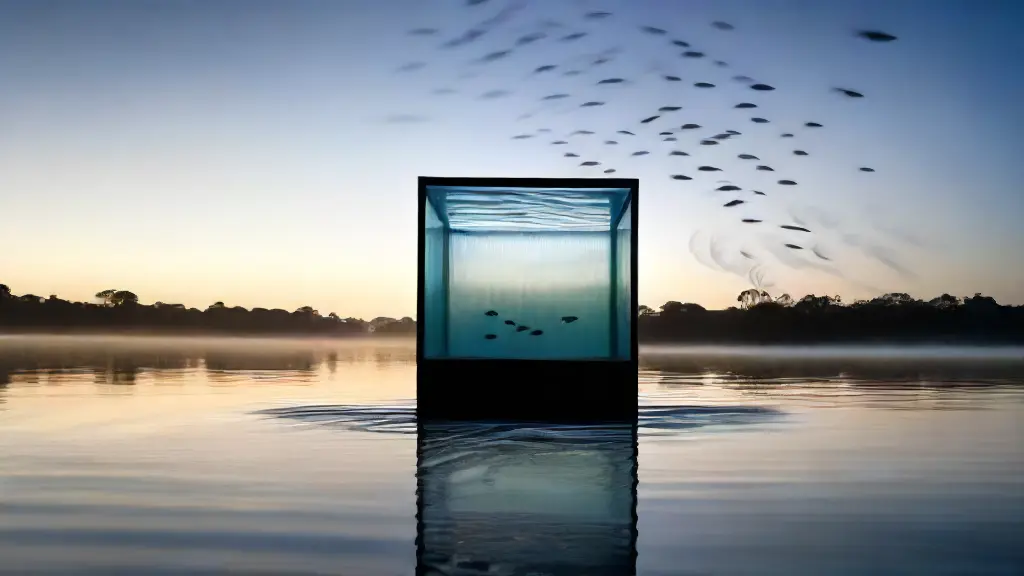These aquatic biodiversity-rich ecosystems are susceptible to disruption when faced with stressors, leading to changes in fish behavior and potentially altering the balance of the ecosystem. The study of behavioral adaptations in aquatic ecosystems is crucial for understanding and preserving aquatic biodiversity.
Environmental Pressure on Bait Fish Behavior
The intricate relationships between aquatic life and their environments are a guiding force in shaping the behavior of bait fish, influencing their survival and the delicate ecological balance in our waterways.
Water temperature has a profound impact on bait fish behavior, with changes influencing their activity and feeding patterns. For instance, the yellow perch is known to become more active and feed voraciously during temperature fluctuations, while the bluegill tends to be more sluggish in colder waters.
Water quality is another crucial factor, with changes in pH and dissolved oxygen levels significantly affecting bait fish behavior and survival.
Maintaining healthy fish physiology in these environments is vital for bait fish, and its implications for live bait management are significant, particularly for species like the fathead minnow that are sensitive to these changes. significantly affected by the interplay of light and darkness.

Ecological Balance Impact
The fragile harmony between humans and aquatic ecosystems is increasingly under threat due to the cumulative effects of environmental pressures on the world’s waterways.
Water pollution, a dominant stressor, wreaks havoc on aquatic life.
Strong chemicals and pollutants from agricultural runoff and industrial activities can irreversibly alter the natural pH levels of waterways, causing widespread harm to fish populations and other aquatic species.
In addition to water pollution, overfishing is another significant contributor to ecological imbalance.
When fish populations are overfished, it disrupts the intricate food chain, leaving vulnerable species without a crucial food source. This can have severe consequences, including population declines or even extinctions.
Awareness of the unintended consequences of bait fish behavior is crucial to comprehending the ecological balance impact. By understanding these effects, we can better navigate the delicate balance between human activities and aquatic ecosystems.
Aquatic Ecosystems
- More than 80% of the world’s wastewater is released into the environment without adequate treatment, contributing to water pollution.
- The average American generates about 100 pounds of plastic waste per year, with a significant portion of it ending up in waterways and harming aquatic life.
- Fishing industries are responsible for 14% of global greenhouse gas emissions, with overfishing and destructive fishing practices exacerbating the issue.
- It is estimated that 1/3 of the world’s fish stocks are overfished, with 60% being maximally fished, and only 7% being underfished.
Stress Management Strategies
When we embark on a fishing trip, we often focus on our gear, the type of fish we’re after, and the ideal spots to cast our lines. It’s equally important to tune in to our own mental wellbeing, as stress can quickly derail an otherwise enjoyable experience.
Understanding the dynamics of predator-prey relationships can have a profound impact on our emotional state when fishing.
For instance, patience is a vital component of bait fish ecology, as it allows us to stay focused and avoid exhaustion.
By recognizing the signs of environmental stress, we can avoid letting the frenzy of emotions take over and ruin our trip.
Adapting to changing conditions is essential in fishing, and this principle also applies to managing live bait. Effective strategies for stress management include using the right type of bait, handling it correctly, and minimizing hook sets outside of regular fishing hours.
Fish Behavior Adaptations
Life underwater is a constant dance of adaptation, as fish navigate the intricate balance of their aquatic ecosystems.
From altered water chemistry to shifts in their social structures, fish must constantly adapt to survive. One of the most impressive ways they do this is through camouflage and concealment.
Certain species have developed an extraordinary ability to blend into their surroundings, thanks to their body coloration, pattern, and texture.
Some fish can change color to match their environment, while others have evolved to mimic the patterns and shapes of their surroundings.
The anglerfish, with its striking lure on top of its head, is a master of camouflage.
It can change the color and pattern of its body to match the surrounding environment, making it nearly invisible. Fish also employ stealth to sneak up on prey, with some species.
Water Chemistry Influence
The subtleties of aquatic life rely heavily on the delicate harmony of water chemistry, where minute changes can have far-reaching consequences for the well-being of entire ecosystems.
: Understanding the intricate balance of water chemistry is essential for maintaining the health of aquatic ecosystems.
In fact, environmental monitoring reveals that even slight changes in water chemistry can have significant effects on the ecosystem, much like fish behavior analysis has long suggested.
The pH level of water is a critical factor in determining the overall health of the ecosystem.
At its most basic, pH measures the concentration of hydrogen ions in the water, with a pH of 7 being neutral and lower values indicating acidity.
Alkalinity and hardness are two related concepts that play a significant role in shaping the chemical makeup of water. Alkalinity helps to buffer changes in pH, while hardness determines the level of mineral content, ultimately influencing the health of aquatic organisms in environmental monitoring and fish behavior analysis.
Bait Fish Biology
In the depths of lakes and rivers, aquatic ecosystem resilience thrives, supported by a intricate web of relationships between species. Beneath the surface, a tiny world of life teems, with bait fish playing a vital role in maintaining the delicate balance of their ecosystem.
Adaptations for Survival:
Specially designed sensory organs allow bait fish to detect vibrations and predators, granting them a degree of protection.
Unique physical features such as mottled colorations and slender bodies enable them to blend seamlessly into their surroundings.
Behavioral Responses to Environmental Changes:
When water temperature or quality fluctuates, bait fish adjust their behavior accordingly. This may involve changes in feeding habits or migration patterns to avoid predator-rich waters.
Reproduction and Life Cycle:
Bait fish employ diverse reproductive strategies to ensure their survival, ranging from spawning multiple times a year to protecting their young in complex nest structures.
Fish Population Dynamics
The intricate relationships within aquatic ecosystems rely on a fragile balance between species, where even slight changes can have far-reaching consequences.
Environmental Influences
Water temperature plays a vital role in bait fish biology, as changes in temperature can alter their metabolism, activity levels, and even daily routines, which can be mitigated by stress mitigation strategies.
.
Managing pH levels is also crucial, as it can significantly impact fish habitat and survival, where a balance between acidity and alkalinity is essential for fish to thrive, making it a vital consideration in conservation efforts.
.
Nutrient availability is another crucial factor in determining fish populations and ecosystem health, where a scarcity of nutrients can stifle growth, while an overabundance can lead to an imbalance, which can be mitigated through the implementation of bait fish biology and stress mitigation strategies.
Can I Use Live Bait Safely
In the constant quest to catch the perfect fish, anglers often ponder the use of live bait. Without a doubt, live bait fish are an integral part of aquatic ecosystems, serving as a vital food source for many species.
Understanding their life cycle is crucial for responsible angling, as it affects their behavior and potential impact on the ecosystem.
Live bait fish are an essential component of fish population dynamics, serving as a vital food source for many aquatic species.
Their life cycle is a delicate balance of birth, growth, and migration, with females laying thousands of eggs that hatch into larvae. As they grow, they feed on small invertebrates and begin to migrate to deeper waters, making their life cycle vulnerable to disruptions.
Which can lead to devastating effects on their offspring’s survival and the overall fish population dynamics.
Live Bait Fish
- Females of live bait fish lay thousands of eggs that hatch into larvae.
- Live bait fish feed on small invertebrates as they grow.
- Their life cycle is vulnerable to disruptions, which can lead to devastating effects on their offspring’s survival and the overall fish population dynamics.
- Live bait fish are an essential component of fish population dynamics, serving as a vital food source for many aquatic species.
Best Times of Year to Use Bait Fish
Best Techniques for Understanding Bait Fish Movement Patterns




